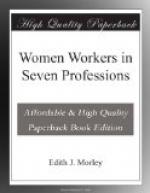It is true that the direct facing of these wider problems does not fall to the lot of the assistant mistress in her earlier years. But the ambitious aspirant to a profession looks to the possibility of a judgeship or bishopric in choosing his life-work. The capable woman then will look at all the possibilities in the teaching profession. Long before she is Headmistress she will have made her mark in her school—for not only the numerous activities mentioned but also the organisation of ordinary school work require initiative and self-reliance. The head of a large school is only too glad to hand over to a competent assistant the organisation of her own department and its co-ordination with other school activities.
Just because there are now openings in other branches of work for women of the highest power, those of this type should give teaching some consideration. Since it has ceased to be the only avenue for trained and educated women, it is no longer so crowded with them, and as in other callings, there is plenty of room at the top.
In addition to a degree, the qualification of training is a strong recommendation.[4] It involves, as a rule, a year after graduation, in special colleges such as exist in Oxford, Cambridge, or London, or in the Secondary Training Department of one or other of the local Universities. The expense varies, usually meaning a fee of about L10 to L30 in addition to cost of living; so that a fairly expensive year intervenes between graduation and the commencement of a salary. Alternatives to a training-college course have been recently suggested by the Board of Education, and may shortly be available. During the training period the intending teacher must, if this is not already determined, decide on the special branch for which she wishes to prepare, according to her qualifications and the needs of schools. If actual teaching experience can first be obtained for two or three years, it enables earning to begin at once and greatly increases the value of the training taken subsequently.
The secondary teacher thus spends from three to five years in academic and professional training; and in accordance with current economic ideas should receive a salary proportionate to the outlay involved. The scheme of salaries approved by the Assistant Mistresses’ Association in January 1912 suggests L120 as the initial minimum salary (non-residential) for a mistress with degree and training, rising in ten years to L220 in ordinary cases, to L250 where “positions of special responsibility” are occupied. L100 to L180 is suggested for non-graduates. “These salaries are higher than those provided by the Girls’ Public Day School Trust, and other governing bodies outside the London County Council. In most cases L120 to L130 a year may be taken as a fair average for an assistant mistress."[5] Headmistresses’ salaries vary from L200 to, at least in one exceptional case, L1,500. They often depend in part on capitation fees. The Headmistresses’ Association considers that the minimum should be L300.




